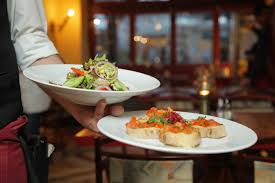Food Restaurants: Savoring Culinary Delights
Food restaurants have always held a special place in our hearts and on our taste buds. These establishments are not just places to satiate our hunger; they are vibrant hubs where flavors, aromas, and cultures blend to create memorable dining experiences. From casual eateries to fine dining establishments, food restaurants cater to diverse palates and offer a gateway to culinary exploration.
One of the greatest joys of visiting a food restaurant is the opportunity to embark on a gastronomic adventure. Each restaurant has its own unique identity, showcasing a fusion of traditional recipes, innovative techniques, and locally sourced ingredients. Whether you’re craving mouthwatering steaks, exotic seafood delicacies, or vegetarian delights, there is always something for everyone.
Beyond the menu offerings, food restaurants provide an ambiance that enhances the overall dining experience. From cozy and intimate settings with dim lighting and soft music to lively and bustling atmospheres with open kitchens and vibrant decor, these spaces are carefully designed to complement the culinary journey. The artistry extends beyond the plate as chefs meticulously present their creations like works of art.
Food restaurants also play an essential role in fostering community connections. They serve as meeting points for friends catching up over brunch or families celebrating special occasions. They become the backdrop for business meetings or romantic dates where conversations flow freely amidst the clinking of glasses and laughter. In these spaces, relationships are strengthened and memories are made.
Moreover, food restaurants have become platforms for showcasing cultural diversity. Many establishments specialize in cuisine from specific regions around the world, allowing patrons to travel through their taste buds without leaving their city. From Italian trattorias serving handmade pasta to Indian curry houses offering aromatic spices, these restaurants celebrate global flavors and promote cross-cultural understanding.
In recent years, food restaurants have also embraced sustainability and ethical practices. Many establishments prioritize locally sourced ingredients from farmers who practice organic farming methods. Some even implement eco-friendly initiatives, such as reducing food waste and using biodegradable packaging. By supporting these restaurants, patrons not only indulge in delectable meals but also contribute to a more sustainable future.
The COVID-19 pandemic has undoubtedly posed challenges for the food restaurant industry. However, it has also sparked innovation and resilience. Many restaurants have adapted by offering takeout and delivery services, ensuring that customers can still enjoy their favorite dishes from the comfort of their homes. Online platforms have become virtual menus, allowing patrons to explore various options and place orders with ease.
Food restaurants are not just places to satisfy our hunger; they are an integral part of our social fabric. They provide a haven for culinary exploration, a platform for cultural exchange, and a space where memories are created. So, the next time you step into a food restaurant, take a moment to appreciate the artistry behind each dish and savor every bite as you embark on an unforgettable journey of flavors and experiences.
5 Essential Tips for Dining Out at Restaurants
Do your research
When it comes to dining out at food restaurants, one tip that can greatly enhance your experience is to do your research. With countless options available, taking the time to explore and gather information about different restaurants can make a world of difference.
Start by reading reviews and recommendations from reliable sources. Online platforms, such as review websites or food blogs, provide valuable insights into the quality of food, service, and ambiance. Pay attention to specific details that align with your preferences, whether it’s a cozy atmosphere or a particular type of cuisine.
Consider the restaurant’s menu offerings. Take a look at their website or social media pages to get an idea of the dishes they specialize in. Are you in the mood for comfort food, exotic flavors, or something light and refreshing? Knowing what each restaurant excels at will help you make an informed decision.
Another aspect to consider is the location and accessibility of the restaurant. Is it conveniently located near your home or workplace? Is there ample parking available? These factors can impact your overall dining experience, especially if you have time constraints or specific transportation needs.
Additionally, take note of any special features or events offered by the restaurant. Some establishments may have live music performances, themed nights, or seasonal menus that add an extra layer of excitement to your visit. By doing your research ahead of time, you can plan accordingly and ensure you don’t miss out on any unique experiences.
Lastly, don’t forget to check if reservations are required. Popular restaurants often fill up quickly, especially during peak hours or on weekends. Making a reservation in advance will save you from disappointment and guarantee you a table when you arrive.
Doing your research before choosing a food restaurant allows you to tailor your dining experience according to your preferences and expectations. It helps ensure that every bite is enjoyable and every moment spent at the restaurant is memorable. So next time you’re planning a meal out, take some time to explore your options and make an informed decision. Your taste buds will thank you!
Check out the menu
When it comes to dining out at food restaurants, one of the most important tips is to always check out the menu. The menu serves as a window into the world of flavors and culinary delights that await you. It not only helps you decide on your meal but also gives you a glimpse into the restaurant’s identity and specialties.
By perusing the menu, you can get a sense of the restaurant’s style and cuisine. Some restaurants focus on specific types of cuisine, such as Italian, Mexican, or Asian, while others offer a diverse range of dishes from around the world. Take your time to read through the descriptions and explore the different options available.
Checking out the menu also allows you to consider dietary restrictions or preferences. Many restaurants now offer vegetarian, vegan, or gluten-free options to cater to a variety of dietary needs. By reviewing the menu in advance, you can ensure that there are suitable choices for everyone in your party.
In addition to exploring main courses, pay attention to appetizers, soups, salads, and desserts. These smaller dishes can add depth and variety to your dining experience. It’s worth noting any signature dishes or chef’s specials that may be highlighted on the menu – these often showcase unique flavors or seasonal ingredients.
Another benefit of reviewing the menu is that it helps you plan your budget. Prices are typically listed alongside each item, allowing you to gauge how much you may spend during your visit. This way, there are no surprises when it comes time to settle the bill.
If possible, take advantage of online menus provided by many food restaurants today. This allows you to explore their offerings in advance and make an informed decision even before stepping foot in the establishment. Online menus often provide additional details about ingredients or cooking methods that can help inform your choices.
So remember, before embarking on a culinary adventure at a food restaurant, take a moment to check out the menu. It will guide you towards delicious discoveries, help accommodate dietary needs, and ensure a delightful dining experience for all.
Ask questions
When it comes to dining at food restaurants, one simple tip can elevate your experience to new heights: ask questions. Whether you’re a seasoned foodie or someone who simply enjoys good meals, asking questions allows you to delve deeper into the culinary world and make more informed choices.
Asking questions at a food restaurant opens up a world of possibilities. Curiosity is the key that unlocks hidden gems on the menu and uncovers the stories behind each dish. Don’t be afraid to inquire about ingredients, cooking techniques, or even the inspiration behind a particular creation. This not only satisfies your curiosity but also shows your genuine interest in the culinary journey.
By asking questions, you can also uncover valuable information about dietary restrictions or allergens in certain dishes. The staff at food restaurants are there to assist you and ensure that your dining experience is enjoyable and safe. They can guide you towards options that suit your preferences or help modify dishes to accommodate any dietary needs.
Moreover, engaging in conversation with restaurant staff allows you to tap into their expertise and recommendations. They are well-versed in the flavors and nuances of each dish and can provide valuable insights on what pairs well together or what specialties the restaurant is known for. Their knowledge can help guide your choices and enhance your overall dining experience.
Asking questions also fosters a connection between patrons and the restaurant itself. It shows that you value their expertise and are invested in understanding their culinary offerings. Many restaurants take pride in sharing their stories, sourcing methods, or even local partnerships. By asking questions, you engage in a dialogue that goes beyond just ordering food; you become part of a larger narrative.
So next time you find yourself seated at a food restaurant, remember to embrace curiosity and ask questions. Explore the menu with an open mind, seek recommendations from knowledgeable staff members, and discover the stories behind each dish. Your dining experience will be enriched as you embark on a journey of flavors, connections, and culinary discovery.
Tip generously
Tip Generously: Appreciating the Culinary Experience
When dining at food restaurants, one small act of kindness can go a long way – tipping generously. While tipping is not mandatory, it is a gesture that holds great significance in the food service industry. It not only shows appreciation for the hard work of restaurant staff but also contributes to their livelihoods.
Behind every delicious meal, there is a team of dedicated individuals working tirelessly to ensure a memorable dining experience. From the servers who greet you with a warm smile and guide you through the menu to the chefs who meticulously prepare each dish with skill and passion, these professionals pour their hearts into their craft.
By tipping generously, you acknowledge and value their efforts. It serves as a tangible expression of gratitude for their commitment to providing exceptional service. Your generosity can make a significant impact on their lives, helping them support themselves and their families.
Moreover, tipping generously encourages a positive cycle within the food service industry. When staff members feel appreciated and fairly compensated for their hard work, they are motivated to continue delivering outstanding service. This creates an atmosphere of professionalism and dedication that benefits both patrons and restaurant employees.
It’s important to remember that tipping should be based on the quality of service received. If you had an exceptional dining experience with attentive staff who went above and beyond, consider leaving a higher tip than usual as a token of your appreciation. On the other hand, if your experience was less satisfactory due to factors beyond the control of the staff (such as kitchen delays or crowded conditions), it’s still important to recognize their efforts with a fair tip.
In some cultures, tipping customs may vary. It’s always helpful to familiarize yourself with local practices when traveling or dining in different regions. However, regardless of cultural norms, showing gratitude through tipping is universally understood as an act of kindness and appreciation.
So next time you enjoy a delightful meal at your favorite food restaurant or discover new flavors at a local eatery, consider tipping generously. Your generosity not only supports the hardworking individuals who make your dining experience possible but also contributes to a culture of appreciation within the food service industry. Together, we can create an environment where everyone feels valued and inspired to continue delivering exceptional culinary experiences.
Leave feedback
Leave Feedback: Enhancing the Dining Experience
When it comes to food restaurants, your voice matters. Leaving feedback is not only a way to express your satisfaction or dissatisfaction; it is an opportunity to contribute to the improvement of dining experiences for yourself and others. Whether it’s through online reviews, comment cards, or direct communication with restaurant staff, your feedback plays a crucial role in shaping the future of these establishments.
Positive feedback acts as a pat on the back for the hardworking chefs, servers, and staff who strive to provide exceptional service. It encourages them to continue their efforts and reinforces their commitment to excellence. By sharing your positive experiences, you not only uplift the spirits of those who work tirelessly behind the scenes but also inspire others to visit and experience the restaurant’s offerings.
On the other hand, if you encounter any issues during your dining experience, providing constructive criticism can help address those concerns and drive positive change. Restaurant owners and managers value honest feedback as it helps them identify areas for improvement. Whether it’s about slow service, undercooked food, or any other aspect that fell short of expectations, sharing your thoughts can lead to corrective actions that enhance future visits for both yourself and other patrons.
When leaving feedback, it’s important to be specific and objective. Describe your experience in detail, mentioning what stood out positively or negatively. This helps restaurant management understand the situation accurately and take appropriate measures accordingly. Remember that constructive criticism is about offering suggestions for improvement rather than simply venting frustrations.
In today’s digital age, online review platforms have become powerful tools for consumers to share their opinions about food restaurants. These platforms allow you to reach a wide audience and influence potential customers’ decisions while also giving restaurants valuable insights into customer preferences. When leaving an online review, be honest yet fair in your assessment. Highlight notable aspects such as exceptional dishes or outstanding service while also addressing any areas that need attention.
It’s worth noting that leaving feedback is not limited to negative experiences. Even if your visit was satisfactory, sharing your thoughts can help restaurants maintain their high standards and continue delivering exceptional dining experiences. Additionally, don’t hesitate to express gratitude for outstanding service or exceptional meals. Positive feedback can brighten someone’s day and reinforce the positive aspects of a restaurant’s offerings.
By leaving feedback, you become an active participant in shaping the future of food restaurants. Your opinions hold weight and can influence the quality of service, menu offerings, and overall experiences for yourself and others. So, take a moment to reflect on your dining experiences and make your voice heard. Together, we can contribute to a thriving restaurant industry that continually strives to exceed expectations and create memorable moments for all who walk through their doors.











